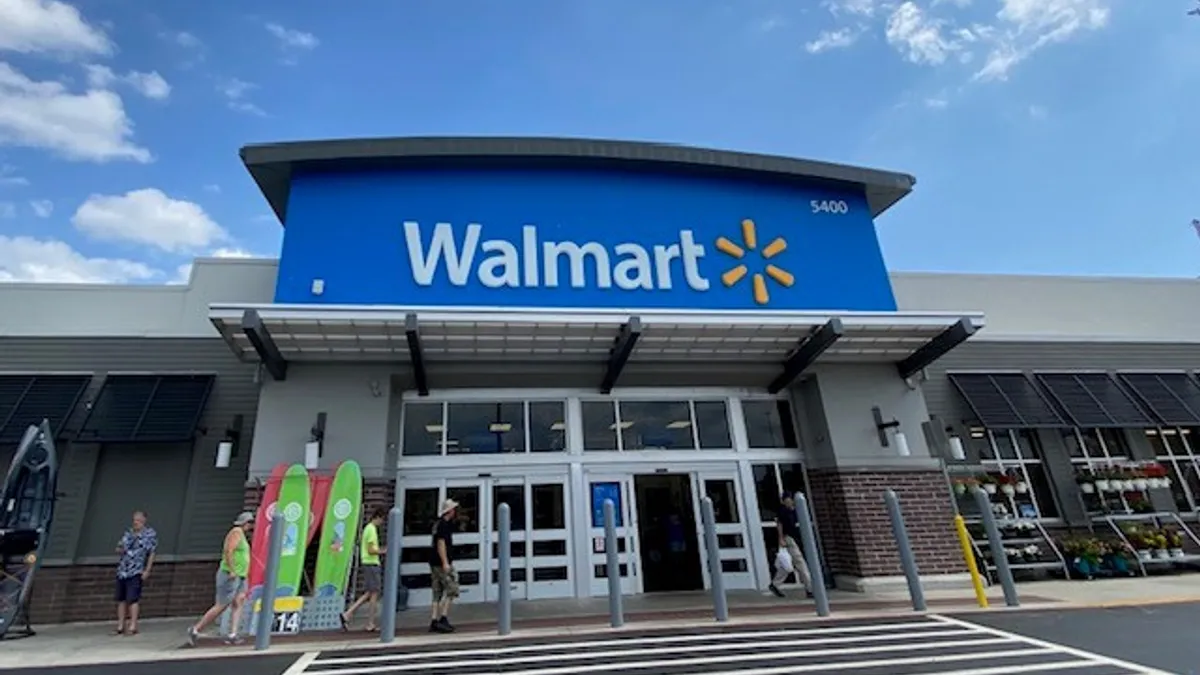As Walmart chips away at its environmental, social and governance (ESG) goals, the retailer is well aware it occupies a global spotlight and that investors, employees and customers are watching closely, the company’s sustainability head said at a recent investment firm event.
Due to its size and scale, Walmart sees itself in a prime spot to be a role model for other businesses on the ESG front, Kathleen McLaughlin, executive vice president and chief sustainability officer at the retailer, said Wednesday during the 2023 Goldman Sachs Global Sustainability Forum.
“As a big retailer, how do we shift consumption toward a more circular approach not only in packaging and things like that, but the materials themselves and products?” said McLaughlin.
But the retailer is also facing an increasingly politicized environment, data challenges and other headwinds, noted McLaughlin, who joined Walmart in 2013 after more than two decades at consulting firm McKinsey & Co.
During the session, McLaughlin outlined Walmart’s position on key ESG issues, described challenges the retailer is facing and pointed to areas where the company has made progress.
Overarching approach
Walmart has four key areas under its ESG efforts, McLaughlin said. They are: economic opportunities for its own workers and suppliers; enhancing the sustainability of its retail operations and supply chain; strengthening communities; and ethics and integrity as an international business, which includes “role modeling standards” around corporate governance and digital citizenship.
During the past 15 years, there’s been a shift with businesses moving from viewing these types of efforts as “side projects” under a “corporate social responsibility mindset” to dedicating special projects as part of a holistic approach that factors these areas into the broader business strategy, McLaughlin said.
Walmart tackles each of its four areas by first setting goals that factor in the business, societal and stakeholder perspectives, then determining the strategies and metrics to work toward the desired outcomes and finally disclosing its efforts, McLaughlin said.
One of the marquee goals for Walmart is its pledge to achieve zero emissions across its global operations by 2040. McLaughlin said that goal is “central to business success” for Walmart.
While there has been some backlash to ESG efforts by businesses as well as ongoing skepticism or denial of climate change, McLaughlin’s comments defended Walmart’s emphasis on ESG. The company is feeling the aftermath of heat events, natural disasters and supply chain changes like shifting yields and quality of commodities, McLaughlin said, characterizing the retailer’s view on climate impacts as a “pervasive, secular risk that is affecting every part of society.”
“It matters at many levels for business for our customers, for our communities,” she said, noting that ESG efforts are “very integrated” into Walmart’s financial guidance.
Climate priorities
With “E” often the main focus of “ESG,” the investment firm event included questioning McLaughlin on Walmart’s climate priorities and efforts so far.
Electricity accounts for the largest part of Walmart’s scope 1 and 2 emissions, she said. Refrigeration efforts, like converting to low global warming potential (GWP) refrigerants across its entire fleet, are “technically possible,” but McLaughlin said a global rollout is difficult due to the retailer’s scale: “We're still experimenting with different technologies, but we think it's doable. And by 2040, we need to figure out how to get there,” she said.
On the transportation front, McLaughlin noted the company has made headway with energy efficiencies for its last-mile fleet — for example, the retailer said last summer it will buy 4,500 all-electric delivery vehicles from EV manufacturer Canoo to fulfill e-commerce orders in 2023.
For its heavy tractors, Walmart is facing shortcomings with technology and batteries that can support those vehicles’ loads and distances, she said. More innovation and experimentation is needed, she said, adding that the retailer is looking into fuel cell power.
McLaughlin said she is most excited about Walmart’s EV charging network. The network currently spans over 250 sites across the U.S., and Walmart plans to expand it to “thousands” of locations, she said.
“[EV charging] makes perfect sense for us,” she said, noting that EV charging is an extension of the retailer’s automotive care business. “They're going to be fast chargers, so it'll be great and attractive for customers. They come and plug in, and even if it takes 15-20 minutes, [they] can come in the store and pick up a few groceries.”
Walmart also has “a lot of untapped real estate” that it can utilize for rooftop solar projects, she said, noting that tax equity deals and community solar offerings make that project more enticing for the company.
Headwinds ahead
Amid more expectations around ESG reporting, accurately measuring scope 3 emissions continues to be a challenge for Walmart, McLaughlin said. Other retailers and grocers face similar data collection issues with scope 3 as well.
McLaughlin recalled that Walmart estimated its scope 3 emissions when it set its initial target for that type of emissions a few years ago. While the company has a “better sense” of what its scope 3 emissions footprint is, the lack of item-level emissions data and the resulting difficulty in creating a comprehensive footprinting analysis continue to pose obstacles, she said.
“We're probably decades away from having excellent information at that level that you can compare from one item to another one company to another,” she said. “So that's one challenge.”
Walmart doesn’t want to get bogged down by the lack of complete data and has been pushing forward with its work to decarbonize the supply chain, McLaughlin added.
The retailer’s Project Gigaton initiative to reduce or avoid supply chain emissions by 1 billion metric tons by 2030 has now engaged more than 5,000 suppliers, she said.
Walmart is also working to stay on track with its ESG efforts while being among the group of large, national companies that McLaughlin said are often targeted by activist groups focused on specific causes. Additionally, the company is navigating a political environment with “a lot of division” that influences stakeholders’ questions, she said.
McLaughlin said she responds to these questions by outlining the three-part litmus test the retailer uses when evaluating ESG requests from its employees, communities, policymakers, suppliers and customers. When a request comes in, Walmart asks if it is relevant to its business, how stakeholders feel about it and how the company’s engagement would make the outcome better or worse, she said.
Stakeholders have been receptive to Walmart’s efforts to be authentic about how its ESG-related actions aim to help the company’s customers, workers, suppliers and bottom line, McLaughlin added.























